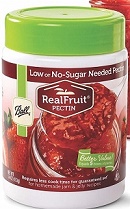
What's in season in January 2025, and other timely information:
Notes for January 2025: Crop growth is slowing down, except for Christmas tree farms and if you live in southern California, southern Texas, Florida or along the Gulf coast where citrus are starting, and believe it or not, the blueberry and strawberry season in those areas is about to begin. See your state harvest calendar . This year, much of the country is still seeing mild weather, so lettuce, peas, broccoli, cabbage and other greens are thriving. And this is a good time to get a canner and learn how to preserve foods for the winter, like canning some applesauce, apple butter or jam, which make great gifts. As do your own homemade specialty liqueurs! How about homemade cranberry sauce or a pumpkin pie made from a real pumpkin for the holidays? See our comprehensive list of easy home canning, jam and jelly making, preserving, drying and freezing directions. You can access recipes and other resources from the drop down menus at the top of the page or the site search. A fun winter activity is to make your own ice cream, even gelato, or low fat or low sugar ice cream - see this page. If you have any questions or suggestions, feel free to write me!
Valentine's Day - February 14 - See this website for Valentines Day history, facts and Amazon's top picks for fast, easy, inexpensive gifts for the man, woman or children in your life!
Easter will be April 4, 2021 - if you want to take your children to a free Easter egg hunt - see our companion website to find a local Easter Egg hunt!
Children's Consignment Sales occur in both the Spring and Fall See our companion website to find a local community or church kid's consignment sale!
Home-made, Home-canned Blackberry Jam
How to Make Homemade Blackberry Jam - Easily!
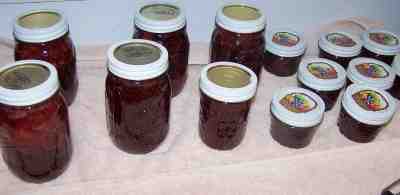 (also Tayberries,
Marionberries, Ollalieberries, Boysenberries, Loganberries, etc.)
(also Tayberries,
Marionberries, Ollalieberries, Boysenberries, Loganberries, etc.)
Making
and canning your own blackberry jam is also quite easy. Just scroll down
this page to see how to do it, in easy steps and completely illustrated.
These directions work equally well for boysenberry, dewberry, gooseberry, loganberry, marionberry,
tayberry, youngberry, etc.; by themselves or mixed
berry jam. Any variations will be spelled out in the directions inside the
pectin.
- I've got some other pages for specific types of jam and butters, too, see this page
- For more information about blackberries, see blackberry picking tips .
- See this page for an easy recipe for seedless blackberry pie!
Ingredients and Equipment
Ingredients
- Blackberries - preferably fresh, but frozen (without syrup) works, too. A batch requires 5 to 6 cups of crushed berries, so you will need about 9 cups of raw whole blackberries.
- Pectin - 1 package (box usually) or if you get it in bulk, 8 Tablespoons, see the directions below for specifics - (it's a natural product, made from apples and available at grocery stores (season - spring through late summer) and local "big box" stores. It usually goes for about $2.00 to $2.50 per box. You will get best results with no-sugar needed pectin, whether you choose to add sugar or not! See here for more information about how to choose the type of pectin to use.
- Lemon juice - OPTIONAL - 1/4 cup per batch; bottled is actually considered more reliable in pH than fresh.
- Sugar - About 4 cups of dry, granulated (table) sugar. For the no-sugar recipe, click here
Equipment
- Jar funnel ($5 at Target, other big box stores, and often grocery stores; and available online - see this page) or order it as part of the kit with the Jar grabber .
- At least 1 large pot; I prefer 16 to 20 quart Nonstick ceramic coated pots for easy cleanup.
- Large spoons and ladles,
- 1 Water Bath Canner (a huge pot to sanitize the jars after filling (about $30 to $35 at mall kitchen stores, sometimes at big box stores and grocery stores.). Note: we sell canners and supplies here, too - at excellent prices - and it helps support this web site!
- Half pint canning jars (Grocery stores, like Publix, Kroger, Safeway carry them, as do some big box stores - about $7 per dozen 8 ounce jars including the lids and rings)
- Lids - thin, flat, round metal lids with a gum binder that seals them against the top of the jar. They may only be used once.
- Rings - metal bands that secure the lids to the jars. They may be reused many times.

Optional stuff:
- Foley Food Mill - not necessary; useful if you want to remove seeds (from blackberries) or make applesauce.
- Lid lifter (has a magnet to pick the lids out of the almost-boiling water where you sanitize them. ($4 at big box stores or it comes in the kit at left)
- Jar grabber (to pick up the hot jars)- Big box stores and grocery stores sometimes carry them; and it is available online - see this page. It's a tremendously useful to put jars in the canner and take the hot jars out (without scalding yourself!).
The kit sold at right has everything you need, and at a pretty good price:
Jam-making Directions
This example shows you how to make either Blackberry jam, jams from similar berries, like Marionberries, Tayberries, etc., or Strawberry - Raspberry - Blackberry Jam - also called Triple Berry Jam (my favorite, and everyone I give a jar to, says it has become their favorite, too!) But you can use this recipe to make any type of jam; where there is a difference, I will point it out! The yield from this recipe is about 8 eight-ounce jars (which is the same as 4 pints).
Step 1 - Pick the berries! (or buy them already picked)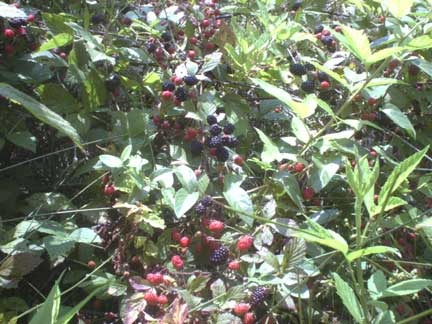
It's fun to go pick your own and you can obviously get better quality ones!
At right is a picture I took of wild blackberries - they are plentiful in late June throughout Georgia. I usually look in rural north Georgia.
I prefer to grow my own; which is really easy - but that does take some space and time.
As
mentioned in the Ingredients section; you may use frozen berries (those without
syrup or added sugar); which is especially useful if you want to make some jam
in December to give away at Christmas!
Above and at left are strawberries and blackberries that I picked at a pick-your-own farm. If you want to pick your own, here is a list and links to the pick your own farms.
How many blackberries?
Jam can ONLY be made in rather small batches - about 6 cups at a time - like
the directions on the pectin say, DO NOT increase the recipes or the jam won't
"set" (jell, thicken). (WHY? Alton Brown on the Food Channel says pectin
can overcook easily and lose its thickening properties. It is easier and
faster to get an even heat distribution in smaller batches. It takes about 8
cups of raw, unprepared berries per batch. For triple berry jam, I use 4 cups of
mushed (slightly crushed) strawberries, 1 cup of raspberries and 1 cup of
blackberries. For strawberry-only jam; you will need 6 cups of mushed
strawberries.
unprepared berries per batch. For triple berry jam, I use 4 cups of
mushed (slightly crushed) strawberries, 1 cup of raspberries and 1 cup of
blackberries. For strawberry-only jam; you will need 6 cups of mushed
strawberries.
Step 2 - Wash the jars and lids
Now's a good time to get the jars ready, so you won't be rushed later. The dishwasher is fine for the jars; especially if it has a "sanitize" cycle, the water bath processing will sanitize them as well as the contents! If you don't have a dishwasher with a sanitize cycle, you can wash the containers in hot, soapy water and rinse, then sanitize the jars by boiling them 10 minutes, and keep the jars in hot water until they are used.
NOTE: If a canning recipe calls for 10 minutes or more of process time in the canner, then the jars do not need to be "sanitized" before filling them. But really, sanitizing them first is just good hygeine and common sense! See this page for more detail about cleaning and sanitizing jars and lids.
Put the lids into a pan of hot, but not quite boiling water (that's what the manufacturer's recommend) for 10 minutes, and use the magnetic "lid lifter wand"
to pull them out. Leave t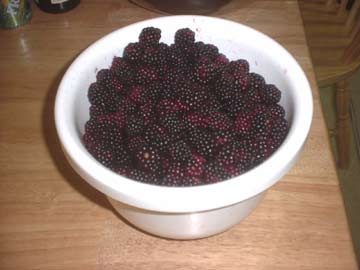 he jars in the dishwasher on "heated dry"
until you are ready to use them. Keeping them hot will prevent the jars from
breaking when you fill them with the hot jam.
he jars in the dishwasher on "heated dry"
until you are ready to use them. Keeping them hot will prevent the jars from
breaking when you fill them with the hot jam.
Step 3 -Wash and hull the blackberries!
I'm sure you can figure out how to wash the fruit in plain cold water.
Then just pick off any stems and leaves.
Step 4a - Deseed the blackberries (optional)
I prefer seedless blackberry jams and jellies. The easiest way to do this is
to use a food mill; either a Foley food mill (a manual hand crank device,) or a
Villaware (manual or motorized) or a Roma mill. I find the seeds separate more
easily if I heat the blackberries up until almost boiling, in a pan with about 1
cup of added apple juice.
As you can see, it is really effective at removing just the seeds:
Here's how the Foley food mill (below) works. They cost about $30.
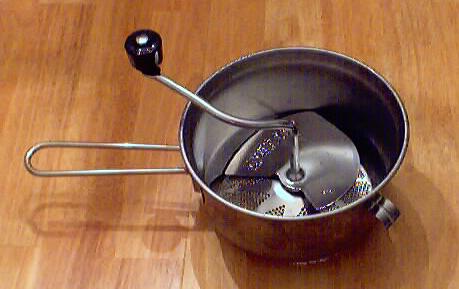
See here for related tools, equipment, supplies on Amazon
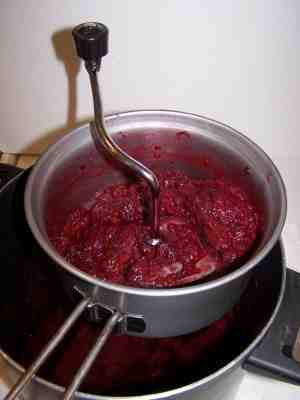
It works well for blackberries, not so well for raspberries, and no one tries to remove strawberry seeds (they're so small). I suppose you could train monkeys to pick them out, but they'd probably form a trade labor union. But I digress..
Step 4 b - Mush the berries - if you did not deseed them
If you decided not to remove the seeds, then you just mush the blackberries up a bit - not completely crushed, but mostly. Most people seem to like large chunks of fruit but crushing them releases the natural pectin so it can thicken. You will need about 6 cups, mushed up.
Step 5 - Measure out the sugar
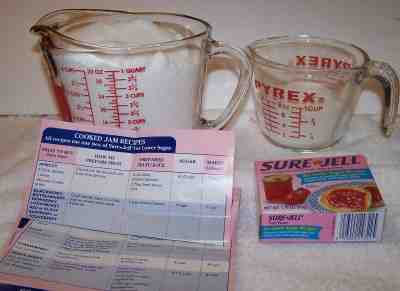
Depending
upon which type of jam you're making (strawberry, blackberry, raspberry,
apricot, peach, grape, etc.) you will need to use a different amount of sugar,
jam and pectin. The precise measurements are found in each and every box of
pectin sold. For most fruit; like berries, with the low sugar pectin, you will need 4 cups of sugar. With regular pectin, about 7 cups of sugar. Mix the dry
pectin with about 1/4 cup of sugar and Keep this separate from the rest of the
sugar. If you are not using sugar, you will just have to stir more vigorously to
prevent the pectin from clumping. This helps to keep the pectin from clumping
up and allows it to mix better!
If you would rather try to make jam with no added sugar, click here for those directions!
| Type of jam |
Type of pectin to buy |
Sweetener |
| regular | no-sugar or regular | 7 cups of sugar |
| low sugar | no-sugar | 4.5 cups of sugar |
| lower sugar | no-sugar | 2 cups sugar and 2 cups of Splenda |
| no sugar | no-sugar | 4 cups of Splenda |
| natural | no-sugar | 3 cups fruit juice (grape, peach, apple or mixed) |
Step 6 - Mix the berries with the pectin and cook to a full boil
Stir
the pectin into the berries, along with the lemon juice, and put the mix in a big pot on the stove over
medium to high heat (stir often enough to prevent burning). It should take about
5 to 10 minutes to get it to a full boil (the kind that cannot be stirred
away).
Lemon Juice: The addition of lemon juice is optional. It is acidic and simply helps the pectin to gel.It also acts as a preservative Blackberries are naturally acidic, so lemon juice is often not needed. I just add lemon as insurance. If you have an allergy to it, skip it!
Why use pectin? You may run into grandmotherly types who sniff "I never used pectin!" at you. Well, sure, and their generation took a horse and buggy to work, died of smallpox and ate canned meat and green beans that tastes like wet newspapers. Old fashioned ways are not always better nor healthier. Pectin, which occurs naturally in fruit, is what makes the jam "set" or thicken. The pectin you buy is just natural apple pectin, more concentrated. Using pectin dramatically reduces the cooking time, which helps to preserve the vitamins and flavor of the fruit, and uses much less added sugar. But, hey, if you want to stand there and stir for hours, cooking the flavor away, who am I to stop you! :) Having said that, there are some fruits that have naturally high amounts of pectin (see this page for a list) and they simply don't need much or even any padded pectin.
Notes about pectin: I usually add about 25% - 30% more pectin (just open another pack and add a little) or else the jam is runnier than I like. With a little practice, you will find out exactly how much pectin to get the thickness you like.
Another tip: use the lower sugar or no-sugar pectin. You can add sugar to either and it cuts the amount of sugar you need from 7 cups per batch to 4 cups or less! And it tastes even better! On the other hand; I have never had success with the No-sugar pectin without adding ANY sugar. It always turned out runny and bland. You might want to try using the low sugar or no-sugar recipe with a mixture of sugar and Splenda; sugar and white grape juice, or just white grape juice - that will cut down the sugar, but still preserve the flavor.

Is your jam too runny? Pectin enables you to turn out perfectly
set jam every time. Made from natural apples, there are also natural no-sugar
pectins that allow you to reduce the sugar you add by half or even eliminate
sugar!
Get canning jars, rings, lids and pectin deliverd:
Step 7 -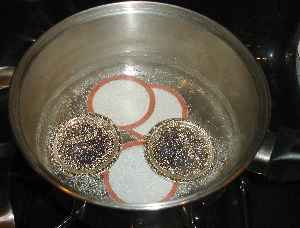 Get the lids warming in hot (but not boiling) water
Get the lids warming in hot (but not boiling) water
Lids: put the lids into a pan of hot water for at least several minutes; to soften up the gummed surface and clean the lids.
Need lids, rings and replacement jars?
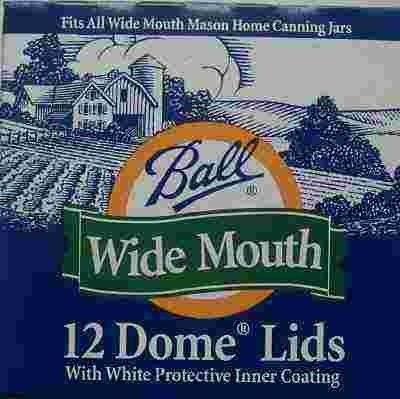

 Get them all here, delivered direct to your home, at the best prices on the
internet!
Get them all here, delivered direct to your home, at the best prices on the
internet!
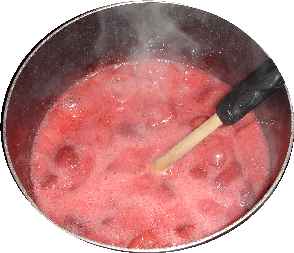
Step 8 - Add the remaining sugar and bring to a boil again for 1 minute
When the berry-pectin mix has reached a full boil, add the rest of the sugar (see step 5) or other sweetener, and then bring it back to a boil and boil hard for 1 minute... If you bring it back to a full boil fairly slowly (on medium heat rather than high) that will help reduce foaming.
Remove from the heat.
Step 9 - Skim any excessive foam
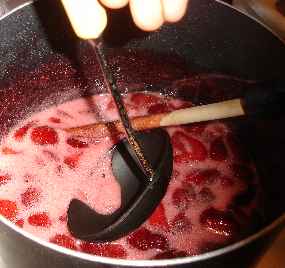 Foam...
What is it? Just jam with a lot of air from the boiling.
Foam...
What is it? Just jam with a lot of air from the boiling. 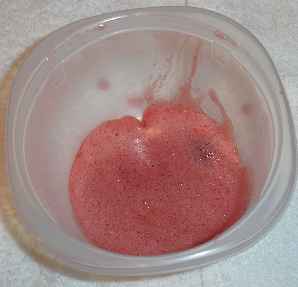 But it tastes more like, well, foam, that jam, so most people remove it.
It is harmless, though. Some people add 1 teaspoon of butter or margarine
to the mix in step 6 to reduce foaming, but food experts debate whether that may
contribute to earlier spoilage, so I usually omit it and skim.
But it tastes more like, well, foam, that jam, so most people remove it.
It is harmless, though. Some people add 1 teaspoon of butter or margarine
to the mix in step 6 to reduce foaming, but food experts debate whether that may
contribute to earlier spoilage, so I usually omit it and skim.
But save the skimmed foam! You can recover jam from it to use fresh! See this page for directions!
Step 10 - Testing for "jell" (thickness)
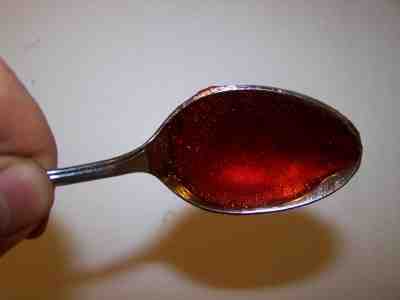 I
keep a metal tablespoon sitting in a glass of ice water, then take a half
spoonful of the mix and let it cool to room temperature on the spoon. If it
thickens up to the consistency I like, then I know the jam is ready. If not, I
mix in a little more pectin (about 1/4 to 1/2 of another package) and bring it
to a boil again for 1 minute.
I
keep a metal tablespoon sitting in a glass of ice water, then take a half
spoonful of the mix and let it cool to room temperature on the spoon. If it
thickens up to the consistency I like, then I know the jam is ready. If not, I
mix in a little more pectin (about 1/4 to 1/2 of another package) and bring it
to a boil again for 1 minute.
Notes about "set" (thickening or jell): It takes 3 ingredients for jams and jellies to set: pectin, sugar and acidity. The amount of pectin that is naturally occurring in the fruit varies from one type of fruit to another and by ripeness (counter intuitively, unripe contains more pectin). See this page for more about pectin in fruit. It takes the right balance, and sufficient amounts of each of pectin, sugar and acidity to result in a firm jam or jelly. Lastly, it takes a brief period (1 minute) of a hard boil, to provide enough heat to bring the three together. Generally speaking, if your jam doesn't firm up, you were short in pectin, sugar or acidity or didn't get a hard boil. That's ok - you can "remake' the jam; see this page!
Step 11 - Optional: Let stand for 5 minutes and stir completely.
Why? Otherwise, the fruit will often float to the top of the jar. This isn't a particular problem; you can always stir the jars later when you open them; but some people get fussy about everything being "just so", so I've included this step! Skipping this step won't affect the quality of the jam at all. I usually don't bother.
You will also notice that the less sugar you use, the more the fruit will float (chemists will tell you it is due to the decreased density of the solution!)
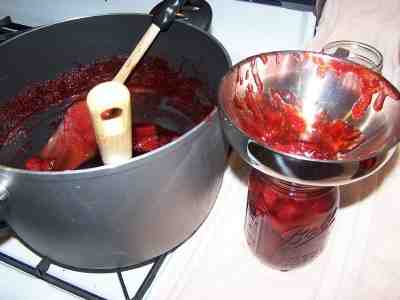 Step
12 - Fill the jars and put the lid and rings on
Step
12 - Fill the jars and put the lid and rings on
Fill
them to within 1/4-inch of the top, wipe any spilled jam off the top, seat the lid
and tighten the ring around them. Then put the filled jars into the canner!
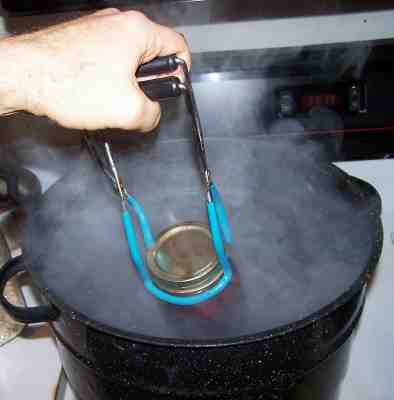
This is where the jar tongs come in really handy!
Step 13 - Process the jars in the boiling water bath
Keep the jars covered with at least 2 inches of water. Keep the water
boiling. In general, boil them for 10 minutes, which is what SureJell (the
makers of the pectin) recommend. I say "in general" because you have to
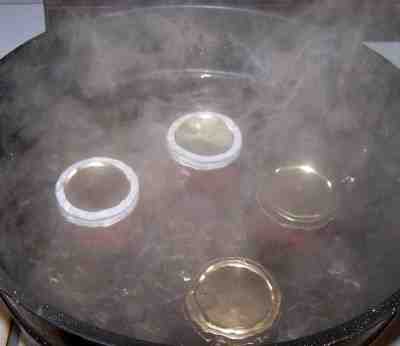 process
(boil) them longer at higher altitudes than sea level, or if you use larger
jars, or if you did not sanitize the jars and lids right before using them.
The directions inside every box of pectin will tell you exactly. The
directions on the pectin tend to be pretty conservative. Clemson
University says you only need to process them for 5 minutes. I usually
hedge my bets and start pulling them out after 5 minutes, and the last jars were
probably in for 10. I rarely have a jar spoil, so it must work. But you
don't want to process them too long, or the jam will turn dark and get
runny. See the chart below for altitude adjustment to processing times, if
you are not in the sea level to 1,000ft above sea level range.
process
(boil) them longer at higher altitudes than sea level, or if you use larger
jars, or if you did not sanitize the jars and lids right before using them.
The directions inside every box of pectin will tell you exactly. The
directions on the pectin tend to be pretty conservative. Clemson
University says you only need to process them for 5 minutes. I usually
hedge my bets and start pulling them out after 5 minutes, and the last jars were
probably in for 10. I rarely have a jar spoil, so it must work. But you
don't want to process them too long, or the jam will turn dark and get
runny. See the chart below for altitude adjustment to processing times, if
you are not in the sea level to 1,000ft above sea level range.
Note: Some people don't even boil the jars; they just ladle it hot into hot jars, put the lids and rings on and invert them, but putting the jars in the boiling water bath REALLY helps to reduce spoilage! To me, it makes little sense to put all the working into making the jam and then not to process the jars to be sure they don't spoil!
|
Recommended process time for jams in a boiling water canner. | ||||
| Process Time at Altitudes of | ||||
| Style of Pack | Jar Size | 0 - 1,000 ft | 1,001 - 6,000 ft | Above 6,000 ft |
| Hot | Half-pints or Pints |
5 min | 10 | 15 |
Step 14 - Remove and cool the jars - Done!
 Lift
the jars out of the water with your jar lifter tongs and let them cool without
touching or bumping them in a draft-free place (usually takes overnight) You can
then remove the rings if you like. Once the jars are cool, you can check that
they are sealed verifying that the lid has been sucked down. Just press in the
center, gently, with your finger. If it pops up and down (often making a popping
sound), it is not sealed. If you put the jar in the refrigerator right away, you
can still use it. Some people replace the lid and reprocess the jar, then that's
a bit iffy. If you heat the contents back up, re-jar them (with a new lid) and
the full time in the canner, it's usually ok.
Lift
the jars out of the water with your jar lifter tongs and let them cool without
touching or bumping them in a draft-free place (usually takes overnight) You can
then remove the rings if you like. Once the jars are cool, you can check that
they are sealed verifying that the lid has been sucked down. Just press in the
center, gently, with your finger. If it pops up and down (often making a popping
sound), it is not sealed. If you put the jar in the refrigerator right away, you
can still use it. Some people replace the lid and reprocess the jar, then that's
a bit iffy. If you heat the contents back up, re-jar them (with a new lid) and
the full time in the canner, it's usually ok.
Once cooled, they're ready to store. I find they last up to 12 months. But after about 6 to 8 months, they get darker in color and start to get runny. They still are safe to eat, but the flavor and texture aren't as good. So eat them in the first 6 months after you prepare them! Another trick is to keep the uncooked berries or other fruit in the freezer and make and can the jam as needed, so it's always fresh.
Illustrated Canning, Freezing, Jam Instructions and Recipes
[ Easy Home Canning Directions] [FAQs - Answers to common questions and problems] [Recommended books about home canning, jam making, drying and preserving!] [Free canning publications to download and print]
Looking for canning equipment and supplies?
Water bath canner with a jar rack
Pressure canners for gas, electric and induction stoves: Presto 23Qt or T-fal 22Qt
Canning scoop (this one is PERFECT)
Ball Blue book (most recent version)
Jars: 8oz canning jars for jams
Find Other types of farms:
Farm markets and roadside stands
Road trips and camping resources
Local Honey, apiaries, beekeepers
Consumer fraud and scams information
Home canning supplies at the best prices on the internet!
Maple Syrup Farms, sugarworks, maple syrup festivals
Environmental information and resources
Farms For Your Event for birthday parties, weddings, receptions, business meetings, retreats, etc.
Festivals - local fruit and vegetable festivals
Get the
most recent version of
the Ball Blue Book
With this Presto 23 quart pressure canner and pressure cooker, you can "can" everything, fruits, vegetables, jams, jellies, salsa, applesauce, pickles, even meats, soups, stews. Model 01781

You can make jams, jellies, can fruit, applesauce, salsa and pickles with water bath canners, like this Granite Ware 12-Piece Canner Kit, Jar Rack, Blancher, Colander and 5 piece Canning Tool Set

